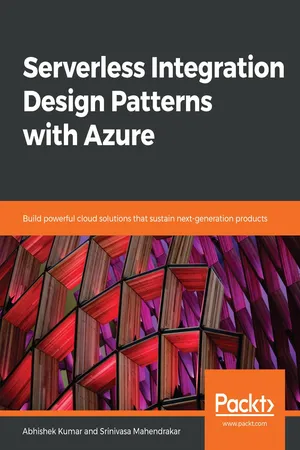
Serverless Integration Design Patterns with Azure
Build powerful cloud solutions that sustain next-generation products
Abhishek Kumar, Srinivasa Mahendrakar
- 494 pages
- English
- ePUB (mobile friendly)
- Available on iOS & Android
Serverless Integration Design Patterns with Azure
Build powerful cloud solutions that sustain next-generation products
Abhishek Kumar, Srinivasa Mahendrakar
About This Book
A practical guide that helps you progress to using modern integration methods and leverage new cloud capability models
Key Features
- Design critical hybrid integration solutions for your organization
- Gain in-depth knowledge of how to build cloud-native integration solutions
- Leverage cognitive services to build smart cloud solutions
Book Description
With more enterprises adapting cloud-based and API-based solutions, application integration has become more relevant and significant than ever before. Parallelly, Serverless Integration has gained popularity, as it helps agile organizations to build integration solutions quickly without having to worry about infrastructure costs. With Microsoft Azure's serverless offerings, such as Logic Apps, Azure Functions, API Management, Azure Event Grid and Service Bus, organizations can build powerful, secure, and scalable integration solutions with ease.
The primary objective of this book is to help you to understand various serverless offerings included within Azure Integration Services, taking you through the basics and industry practices and patterns. This book starts by explaining the concepts of services such as Azure Functions, Logic Apps, and Service Bus with hands-on examples and use cases. After getting to grips with the basics, you will be introduced to API Management and building B2B solutions using Logic Apps Enterprise Integration Pack.
This book will help readers to understand building hybrid integration solutions and touches upon Microsoft Cognitive Services and leveraging them in modern integration solutions. Industry practices and patterns are brought to light at appropriate opportunities while explaining various concepts.
What you will learn
- Learn about the design principles of Microsoft Azure Serverless Integration
- Get insights into Azure Functions, Logic Apps, Azure Event Grid and Service Bus
- Secure and manage your integration endpoints using Azure API Management
- Build advanced B2B solutions using Logic Apps, Enterprise Integration Pack
- Monitor integration solutions using tools available on the market
- Discover design patterns for hybrid integration
Who this book is for
Serverless Integration Design Patterns with Azure is for you if you are a solution architect or integration professional aiming to build complex cloud solutions for your organization. Developers looking to build next-level hybrid or cloud solutions will also find this book useful. Prior programming knowledge is necessary.
Frequently asked questions
Information
Introduction to Azure Event Grid

- Eventing and messaging
- Event sources and event handlers
- Azure Event Grid topics
- Azure Event Grid security and authentication
- Azure Event Grid management access control
- Example 1 – storage events and Logic Apps single event listeners
- Example 2 – custom Azure Event Grid topics and event broadcasts
- Event domains and broadcast events